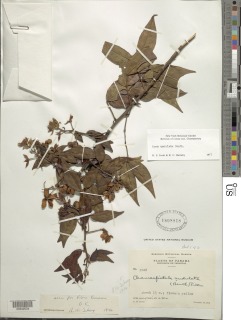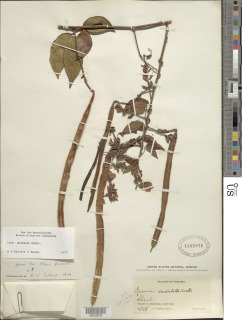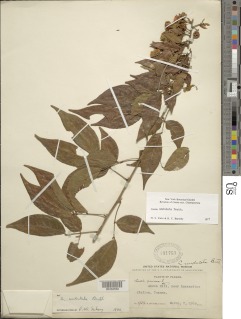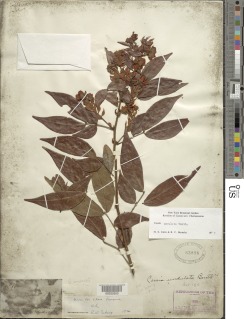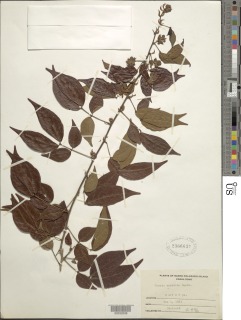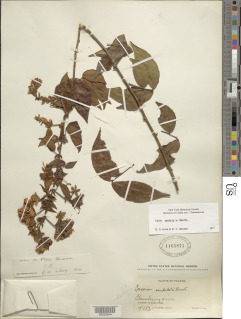

|
|
|
|
Family: Fabaceae
Frijolillo
[Cassia undulata Benth.] |
Descripción: Plantas trepadoras o lianas con las ramitas terminales verdes y ligeramente cubiertas de pelos. Hojas paripinnadas y alternas, con 4 folíolos, opuestos. Los folíolos de 5-11 x 2-4 cm, ovados o lanceolados, con ápice obtuso, agudo o acuminado, bordes enteros y revolutos por el envés. Los folíolos son asimétricos. Estípulas falcadas. Pecíolo de 1.5-3.5 cm de largo y pulvinado en la base. Raquis con una glándula estipitada entre cada par de folíolos. Inflorescencias axilares o terminales. Flores amarillas. Frutos en legumbres, de 8-20 x 0.8-1.2 cm, verdes, tornándose negros al madurar. Especies Parecidas: A menudo se confunde con LK sennda Senna dariensis LK2 , pero S. dariensis es un arbolito pequeño que tiene los folíolos más grandes y anchos. Slender arching shrub or liana, 2-5 m high; older stems glabrous, terete or angulate, lenticellate; younger stems and petioles sparsely to densely pubescent with spreading trichomes. Leaves paripinnate, set on a prominent woody base, mostly less than 15 cm. long; stipules conspicuously falcate, subpersistent; petiole and rachis ribbed above; rachis bearing a raised gland between leaflets of each pair; petiolules short; leaflets 4, lanceolate-subfalcate, acuminate, unequal at base, to 11 cm long and 4 cm wide, +/- glabrous above, dull and with appressed trichomes below, ciliate. Inflorescences racemose-paniculate, terminal or subterminal, puberulent; bracts ovate-lanceolate, ca 8 mm. long, mucronate, persistent; pedicels ca 20 mm long; sepals elliptic to obovate, 7-8 mm long; petals 5, yellow, rounded, cuneate at base, to 15 mm long; anthers conspicuous, 4 large (ca 7 mm long) and 3 small (ca 4 mm long), blunt, with usually 2 terminal pores; style long, pubescent, emerging from one side of flower, recurved over anthers; stigma deeply cup-shaped, the outer margin minutely fringed. Legumes linear, irregularly cylindrical, 10-20 cm long, ca 1 cm thick, usually splitting open on one side; seeds many, smooth, brown, +/- elliptical, flattened, to 5 mm long, stuck together laterally by a sweet, sticky, reddish-black, tarlike substance. Croat 4827 Abundant along the shore. Flowers from November to April, mostly during the dry season. The fruits mature from April to June, possibly later also. The flower unfolds to some extent well in advance of being functional, the petals remaining erect, the anthers closed, and the style recurved with its apex between the stamens. Later (sequence unknown) the anthers become functional, the style uncurls somewhat (the stigma still protruding downward), and the stigmatic cup begins to secrete nectar. Pollen is apparently deposited on the stigma by insects seeking the nectar. Southern Mexico. to northern South America; Trinidad. In Panama, known from tropical moist forest in the Canal Zone and Veraguas and from premontane wet forest in the Canal Zone and Panama. |
|
|
|





















